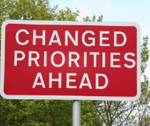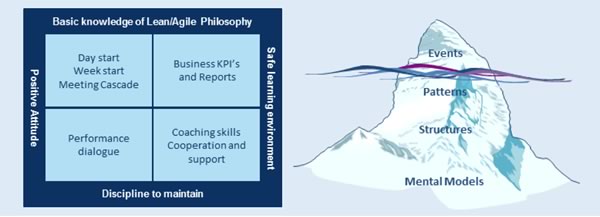As Johan Cruyff used to say: football is simple, but to play football simply is bloody difficult!
Implementing change is similar, as stated in the title. At HillFive we are working with our clients every day to support them in their journey of implementing sustainable change through Lean, Agile or analogous methods to create continuous improvement within their companies. In preparation for a project with one of our clients we have put together an overview of the key ingredients for success. Now that the project is on it’s way, we thought it might be a useful to share our view in this. We hope this will inspire you to make some adjustments for the better or provide confirmation that you are indeed on the right track.
Four key areas for success
In our experience there are four key areas you need to focus on, to have a chance of success in any change- or improvement program. Be aware that this is not a guarantee for success, but merely an overview of minimum requirements to run a successful change or implementation program.
- Ensure Leadership commitment: In short, if the leaders don’t see the need, and do not live the change themselves, why should the employees see it and behave differently?
- Combine the hard and soft: Sustainable change is about redefining processes, systems AND mindset and behaviour. These three elements are working interdependently continuously. If they are defined and communicated in an inconsistent way, this will inevitably create tension and ultimately lead to failed change.
- Build your internal capability: Many companies hire external support to realise change. There is nothing wrong with that, as long as the external effort is also focussed on building the internal capability within the client organisation so that it can become independent of external support. After all, it is YOUR change!
- Formalise the ‘New Way of Working’ into HR Systems: Hire, promote and reward people that display the new way of working. Not the ones who display the ‘old way’. It should not come as a surprise that, when old behaviour is recruited and rewarded, the new and desired behaviour never has a chance!
Ensure leadership commitment
Time: The first ingredient to success is to get the topic on the agenda of the Leadership Team and in their personal calendars. Senior Managers personally have to spend time on the subject. Providing budget is a decoy, not necessarily a sign of commitment. For this reason only budget availability is by far not enough to ensure leadership commitment.
Accountability: Keep the challenge where it belongs: in the line organisation. Line Management is accountable to set and achieve targets. Supporting resources are accountable to provide support. If the support function takes over the accountability (even if it is done out of personal drive and involvement), the sustainability of the change is undermined.
Priority: If you launch ‘just another change program’, it is likely to fail. People’s calendars are full with meetings, projects and programs already running. ‘Do another one on top of’ sends the signal that, if it really comes down to it, the program is of less importance. People will ignore it or, at best, do the window dressing. As soon as you take your eye off the ball, they will drop it! To launch a priority program, you have to deprioritise some of the others that are already running. Or wait until one of them is finished.
Combine ‘hard’ and ‘soft’
Business or process optimisation is as much about processes as it is about competencies, mindset and behaviour. In order to realise sustainable improvement, your need all elements combined.
- Focus on business impact, the tools are only tools. Lean and Agile provide a world class toolset but they are only a means to an end. Create pull for the change by identifying the current challenges and use the tools to support Line Management in dealing with these challenges.
- Take an integral approach: combine development of hard- and soft skills. It is the combination of clear KPI’s, target setting, rigorous progress review and coaching skills that will get sustainable results. Only coaching without targets and objective will get you nowhere. Only targets without coaching will lead to a burn-out. The picture outlines the basic elements we use on a regular basis for shaping the integral approach.
- Shift mental models. Only a change in behaviour does not create sustainable change within your organisation. Impact on the belief system of the organisation and it’s people is required. Mental models drive our behaviour unconsciously.
Figure 1: Building blocks for an internal approach and iceberg for sustainable change
Build internal capability
Maybe a bit of strange advice coming from an external consultant. However, at HillFive we believe very strongly that client organisations are best served, when internal capabilities are built so they become independent of external support. There are three elements vital to ensure that internal capability is built effectively.
Put the best people on the job. A top performing Lean Expert or Agile Coach has great analytical and interpersonal skills. On top of that they have to be independent thinkers without hierarchical limitations. The internal project- or program management team have to be capable of challenging line management.
Recruit a mix of internal and external resources. By hiring a few key players from outside you can bring in different perspectives. In that way you mobilise detailed knowledge of the business through the existing staff involved combined with an external and perhaps more independent view on improvement potential. After all, the objective is to create a change, so a fresh impulse can be very beneficial. It also enables you to rapidly ramp up capability and start a train-the-trainer approach.
Make 0.5 – 1.0% of FTE available as Experts. Make clear that when the program is finished, continuous improvement continues. It seems obvious, but we have seen in multiple cases that really talented people are reluctant to join the program because of lack of career perspective. Continuous Improvement requires continuous effort. Also after the first round of implementation. Accountability is in the line organisation, however that does not mean line management can do it all themselves. Capability needs to remain available for challenge and support.
Formalise into HR Systems
Formalisation of the new competencies into the HR system can give a big boost to driving the new and desired behaviours. It ensures that new recruits have the right profile and that the required behaviours are actively developed and rewarded.
- Build Lean competencies into the recruitment profiles. To ensure that new recruits strengthen the internal drive for the intended change, the recruitment profiles have to be adapted. You do not want to continue to hire people that fit the ‘old’ profile. On top of that you can give new recruits the specific assignment to contribute positively to the change. They do not have the ‘burden of history’ and can play an important role in creating of expanding the momentum for change. This goes for recruitment on all levels, including senior management.
- Develop and implement Lean/Agile competency tables as a coaching and development tool. These competency tables provide a detailed description of the desired behaviours and are important to embed the new way of working and the development of the new behaviour into the daily routine.
- Embed Lean/Agile competencies into the formal performance evaluation methodology. People behave the way they are rewarded. “Tell me the way I will be measured and I will act accordingly.”


 Time: The first ingredient to success is to get the topic on the agenda of the Leadership Team and in their personal calendars. Senior Managers personally have to spend time on the subject. Providing budget is a decoy, not necessarily a sign of commitment. For this reason only budget availability is by far not enough to ensure leadership commitment.
Time: The first ingredient to success is to get the topic on the agenda of the Leadership Team and in their personal calendars. Senior Managers personally have to spend time on the subject. Providing budget is a decoy, not necessarily a sign of commitment. For this reason only budget availability is by far not enough to ensure leadership commitment. Accountability: Keep the challenge where it belongs: in the line organisation. Line Management is accountable to set and achieve targets. Supporting resources are accountable to provide support. If the support function takes over the accountability (even if it is done out of personal drive and involvement), the sustainability of the change is undermined.
Accountability: Keep the challenge where it belongs: in the line organisation. Line Management is accountable to set and achieve targets. Supporting resources are accountable to provide support. If the support function takes over the accountability (even if it is done out of personal drive and involvement), the sustainability of the change is undermined. Priority: If you launch ‘just another change program’, it is likely to fail. People’s calendars are full with meetings, projects and programs already running. ‘Do another one on top of’ sends the signal that, if it really comes down to it, the program is of less importance. People will ignore it or, at best, do the window dressing. As soon as you take your eye off the ball, they will drop it! To launch a priority program, you have to deprioritise some of the others that are already running. Or wait until one of them is finished.
Priority: If you launch ‘just another change program’, it is likely to fail. People’s calendars are full with meetings, projects and programs already running. ‘Do another one on top of’ sends the signal that, if it really comes down to it, the program is of less importance. People will ignore it or, at best, do the window dressing. As soon as you take your eye off the ball, they will drop it! To launch a priority program, you have to deprioritise some of the others that are already running. Or wait until one of them is finished.


